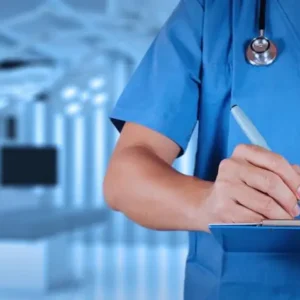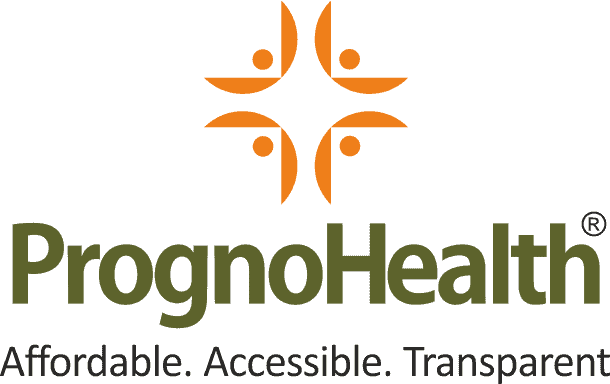PrognoHealth – Corporate Health & Wellness Specialist
Contact Us
+91 9510650660
Email Us
corpsales@prognohealth.com
Contact Us
+91 9510650660
Email Us
corpsales@prognohealth.com
CT Scan of the Thorax
A CT (computed tomography) scan of the thorax, also known as a chest CT scan, is a non-invasive medical imaging test that produces detailed images of the chest and surrounding structures. The test is commonly used to diagnose and evaluate a wide range of lung and chest conditions. In this article, we will discuss the procedure of the CT Scan Thorax, test preparation, common symptoms for ordering the test, time taken for the test, result interpretation, and its importance in corporate health wellness packages.
Test Procedure : During a CT Scan Thorax, the patient lies on a table that slides through a large, doughnut-shaped machine that rotates around the patient’s body. The machine takes multiple images of the chest, including the lungs, heart, blood vessels, and other surrounding structures. The images are then processed by a computer to create detailed, three-dimensional images of the chest. The entire procedure typically takes between 10 to 30 minutes.
Test Preparation : Before a CT Scan Thorax, patients may be asked to refrain from eating or drinking for a few hours, especially if they will receive contrast dye. Contrast dye is a substance that enhances the visibility of certain structures in the body during imaging. Patients should also inform their doctor of any medications they are taking, any allergies they have, and any previous surgeries or medical procedures. In some cases, patients may be asked to wear a hospital gown or remove any metal objects, such as jewelry or piercings.
Common Symptoms for Ordering the Test : A CT Scan Thorax may be ordered by a doctor to investigate the following symptoms or conditions:
Persistent cough or chest pain
Shortness of breath or difficulty breathing
Unexplained weight loss
Fatigue or weakness
Suspected lung or chest infection
Suspected blood clot in the lung
Evaluation of lung nodules or masses
Time Taken for the Test and its Results Interpretation : The CT Scan Thorax usually takes between 10 to 30 minutes to complete. After the test, a radiologist will interpret the images and provide a report to the referring physician. The report will include information about the condition of the lungs, heart, and other structures in the chest, including any abnormalities such as masses, nodules, or signs of inflammation.
Importance in Corporate Health Wellness Packages : CT Scan Thorax is a critical diagnostic tool that can detect and diagnose a wide range of lung and chest conditions. Early detection and treatment of these conditions can help prevent complications, reduce the need for more invasive procedures, and ultimately lead to better health outcomes. By offering CT Scan Thorax as part of corporate health wellness packages, companies can help their employees detect and diagnose these conditions early, leading to better overall health and productivity.
In conclusion, CT Scan Thorax is a non-invasive medical imaging test used to diagnose and evaluate a wide range of lung and chest conditions. Patients do not need to prepare significantly for this test, but they should inform their doctor of any medications they are taking, any allergies they have, and any previous surgeries or medical procedures. Results of the test are interpreted by a radiologist and provided to the referring physician. Companies can offer CT Scan Thorax as part of their corporate wellness packages to help their employees detect and diagnose these conditions early and promote better overall health and productivity.
CT scan of the thorax
A CT scan of the thorax, also known as a chest CT scan, is a diagnostic imaging procedure that provides detailed pictures of the structures within the chest, including the lungs, heart, blood vessels, and bones. This scan is invaluable for diagnosing a variety of conditions related to the respiratory and cardiovascular systems as well as other structures in the chest.
Overview of a Thoracic CT Scan
• CT Scan : Computed Tomography (CT) uses X-rays to create cross-sectional images of the body, offering more detailed information than standard X-rays.
• Thorax : The thorax is the part of the body between the neck and the abdomen. It includes vital structures such as the lungs, heart, esophagus, trachea, and major blood vessels.
Indications for a Thoracic CT Scan
A thoracic CT scan is performed for various reasons, including:
1. Evaluation of Symptoms :
o Persistent cough.
o Shortness of breath.
o Chest pain.
o Hemoptysis (coughing up blood).
2. Detection and Assessment of Conditions :
o Lung Diseases : Such as pneumonia, tuberculosis, interstitial lung disease, and chronic obstructive pulmonary disease (COPD).
o Tumors : Including lung cancer, metastatic disease, and lymphomas.
o Infections : To identify the presence and extent of infections like abscesses.
o Pulmonary Embolism : Blood clots in the lungs.
o Aortic Aneurysms : Enlargement of the aorta.
o Pleural Conditions : Such as pleural effusion (fluid around the lungs) or pneumothorax (collapsed lung).
o Congenital Abnormalities : Birth defects affecting the heart, lungs, or chest structures.
3. Preoperative Assessment :
o Planning for surgeries involving the chest organs.
o Guiding biopsies or other interventional procedures.
4. Monitoring of Chronic Conditions :
o Following up on known tumors or chronic lung diseases.
o Evaluating the effectiveness of ongoing treatments.
Preparation for the Scan
1. Dietary Restrictions : Usually, no fasting is required unless a contrast dye is used.
2. Contrast Use :
o Without Contrast : No special preparation is needed.
o With Contrast : You may be asked to avoid eating for a few hours before the scan. Inform your doctor if you have any allergies or kidney issues, as these can affect the use of contrast dye.
3. Clothing and Jewelry : Remove any metal objects, such as jewelry, that might interfere with the imaging.
4. Medical History : Inform the technician if you have any medical conditions, are pregnant, or have had prior reactions to contrast materials.
Procedure
1. Positioning : You will lie flat on a motorized table. You may be asked to raise your arms above your head.
2. Scanning : The table will slide into the CT scanner, a large doughnut-shaped machine. The scanner rotates around your body, capturing multiple X-ray images.
3. Breath Holding : You may be instructed to hold your breath for short periods to avoid motion artifacts on the images.
4. Duration : The scan usually takes about 5 to 10 minutes, but the entire appointment might take longer, especially if contrast is used.
What Does the CT Scan Show?
A thoracic CT scan provides detailed images of:
1. Lungs :
o Air spaces and lung parenchyma (tissue).
o Identification of lesions, nodules, or masses.
o Patterns of lung disease or infection.
2. Heart :
o Cardiac chambers and structures.
o Coronary arteries (in cardiac CT angiography).
o Pericardium (sac around the heart).
3. Mediastinum :
o Space between the lungs containing the heart, aorta, esophagus, trachea, and lymph nodes.
o Detection of enlarged lymph nodes or masses.
4. Pleura :
o The membranes surrounding the lungs and lining the chest cavity.
o Identification of fluid accumulation or thickening.
5. Bones :
o Rib cage, spine, and sternum.
o Evaluation of fractures or bone lesions.
6. Major Blood Vessels :
o Aorta and its branches.
o Pulmonary arteries.
Interpretation of Results
1. Normal Findings :
o Structures appear normal in size, shape, and position.
o No evidence of masses, infections, or abnormalities.
2. Abnormal Findings :
o Lung Abnormalities: Such as masses, tumors, or signs of infection or inflammation.
o Heart and Vascular Issues : Including enlargement, aneurysms, or calcifications.
o Mediastinal Problems : Such as lymphadenopathy or masses.
o Bone Issues : Fractures, lesions, or degenerative changes.
o Pleural Conditions : Evidence of fluid, thickening, or pneumothorax.
Risks and Considerations
1. Radiation Exposure : CT scans involve higher radiation doses than standard X-rays. However, the benefits usually outweigh the risks.
2. Allergic Reactions to Contrast : Rarely, contrast dye can cause allergic reactions. It’s essential to report any known allergies or previous reactions to your healthcare provider.
3. Pregnancy : Pregnant women should avoid CT scans unless absolutely necessary, due to potential risks to the fetus.
Follow-Up
1. Results Discussion : A radiologist interprets the CT images and sends a report to your doctor, who will discuss the findings and next steps with you.
2. Further Testing or Treatment : Depending on the results, additional tests or treatments may be recommended.
Summary :
A CT scan of the thorax is a powerful diagnostic tool for evaluating a wide range of conditions affecting the chest. Its ability to provide detailed cross-sectional images helps in accurate diagnosis, guiding treatment plans, and monitoring the progression of diseases.
Blog Categories
Top rated products
-
 FB Health Checkup I
Rated 5.00 out of 5
FB Health Checkup I
Rated 5.00 out of 5₹3,000.00Original price was: ₹3,000.00.₹1,770.00Current price is: ₹1,770.00. -
 Young Life Basic
Rated 0 out of 5
Young Life Basic
Rated 0 out of 5₹3,000.00Original price was: ₹3,000.00.₹1,350.00Current price is: ₹1,350.00. -
 COVID 19 Rapid Antigen Test
Rated 0 out of 5
COVID 19 Rapid Antigen Test
Rated 0 out of 5₹668.00Original price was: ₹668.00.₹501.00Current price is: ₹501.00. -
 MFG IND PACK III
Rated 0 out of 5
MFG IND PACK III
Rated 0 out of 5₹3,900.00Original price was: ₹3,900.00.₹2,145.00Current price is: ₹2,145.00. -
 Healthy Life Advance Male
Rated 0 out of 5
Healthy Life Advance Male
Rated 0 out of 5₹15,000.00Original price was: ₹15,000.00.₹8,250.00Current price is: ₹8,250.00.
About Us
Progno Health is a Corporate Health & Wellness Specialist providing services to Pan India. We offer Pre-employment Health Checkup Packages, Annual Health Checkup Packages, Executive Health Checkup Packages, Occupational Health Checkup Packages, and other Health & Wellness Services.




